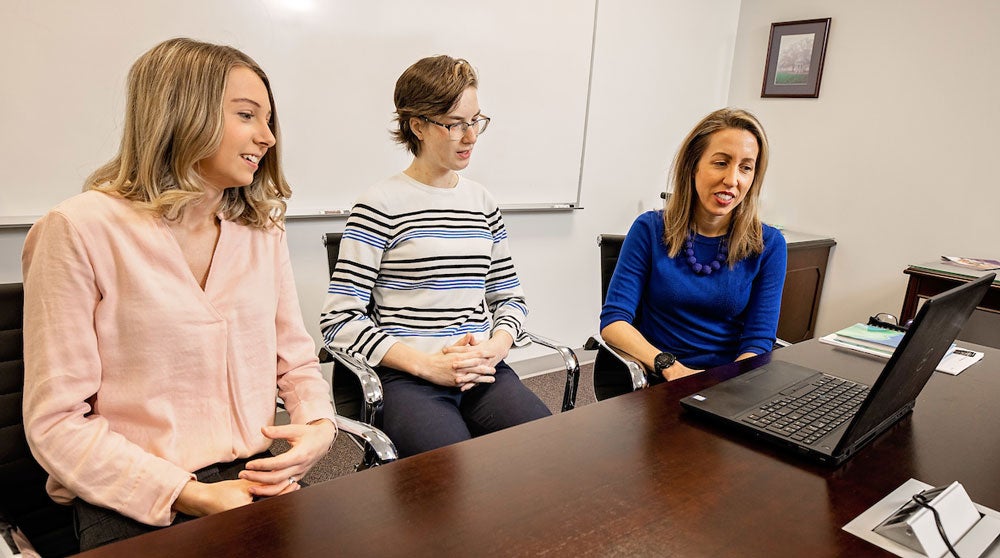FIGHTING OPIOID OVERDOSES
ECU study finds naloxone available at more than half of retail pharmacies surveyed
Researchers at East Carolina University found 3 out of 5 North Carolina retail pharmacies have naloxone in stock for opioid overdoses as part of a statewide standing order. But some independent pharmacies or those in rural areas lack same-day availability or would not sell it without a prescription.
Naloxone, also known as Narcan, is a medication that reverses the effects of an opioid overdose by blocking receptors in the brain and restoring breathing. In 2016, North Carolina enacted a standing order allowing pharmacies to dispense naloxone without a prescription to increase access for people who need it.
Last week, ECU made naloxone available at the Student Health Services pharmacy on main campus.
The ECU study, recently published online in the American Journal of Preventive Medicine, examined the implementation of the statewide standing order through a phone survey developed by Dr. Kathleen Egan and Dr. Joseph G.L. Lee in the Department of Health Education and Promotion in the College of Health and Human Performance at ECU.
The study is the first of its kind in North Carolina, Egan said.
“It’s important to understand if pharmacies are implementing the standing order and if there are variations in implementation by pharmacy type or neighborhood characteristics,” she said.
A random sampling of chain, independent and health department pharmacies from a list of 2,044 active pharmacies provided by the N.C. Pharmacy Board were surveyed. The state publishes a list of pharmacies participating in the standing order.
ECU undergraduate students Ashton Knudsen and Samantha Foster called 200 pharmacies across the state. They asked whether naloxone was available without a prescription, whether they could they get it that day, and how much it cost.
The study found more than half of North Carolina retail pharmacies surveyed have naloxone available without a prescription. All the pharmacies carried intranasal naloxone spray, and 4.1% carried intramuscular naloxone (injection). The average out-of-pocket cost was $123.24 and $33.82 respectively. Seventy-five percent of the pharmacies that would sell naloxone said Medicaid or other forms of health insurance could cover the cost.
The odds of naloxone availability were lower for independent pharmacies than chains. It also was lower in communities with higher percentages of residents with public health insurance, the research showed.
“Chains may have more streamlined protocols to roll out the standing order for naloxone,” Egan said. “There may not be an unwillingness to dispense naloxone without a prescription at the independent pharmacies, rather, they may not have all the information to do so. It could be a stocking issue.”
It was the first research study for Knudsen and Foster, who are majoring in public health studies. Both are certified emergency medical technicians.
Knudsen, a senior from Youngsville, has worked in the 911 system for almost three years and has responded to many opioid overdoses as an EMT.
“Since I work for my county at home, it is really hard to see people in my community struggle with this crisis,” Knudsen said. “I feel that my role as an EMT has greatly contributed to this study. With my experience, I have seen opioid overdose patients in all neighborhoods, regardless of socioeconomic status and that has been a big part that interests me. The opioid crisis is unlike any other in the sense that it has broken all socioeconomic, gender and racial lines. The opioid crisis is one that does not discriminate.”

Public health studies majors Ashton Knudsen and Samantha Foster and faculty member Dr. Kathleen Egan look at data from their research.
In 2018, nearly five North Carolinians died each day from an unintentional opioid overdose. From 1999-2018, more than 14,500 lost their lives to unintentional opioid overdose, according to the N.C. Department of Health and Human Services, which oversees the state’s opioid action plan.
For the survey, Knudsen and Foster also asked about the cost of the medication, which informed the work. “I was able to provide insight from my field experience in emergency medical services, but I was also able to learn more information about costs and access that I can use to help my patients at work,” said Knudsen, who eventually would like to earn a master’s in public health in epidemiology.
Foster, an Honors College junior from Charlotte, helped with data analysis and writing the research manuscript. She isn’t currently working as an EMT but volunteered as an EMT last summer. She would like to attend medical school and potentially become a physician scientist.
Knudsen said she hopes that the research can help individuals who live in rural parts of North Carolina. “Our conclusions indicated a potential inequity in smaller, more rural neighborhoods, which can prevent someone who needs naloxone from having access to it,” she said. “I am hoping this study can also be used to influence future policy regarding the supervision of adherence to the standing order.”
As of January 2019, North Carolina was one of 12 states across the country that had implemented statewide standing orders for naloxone.
Four previous studies were conducted on naloxone availability at pharmacies in California, New Jersey, Minnesota and the city of Philadelphia. North Carolina has the highest percentage of pharmacy participation in states with a standing order in the studies conducted to date.
Efforts to identify the best practices for ensuring widespread implementation of statewide standing orders for naloxone are warranted, the ECU study concluded.
Get more information on naloxone availability in North Carolina.
